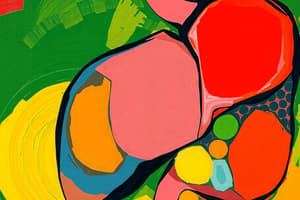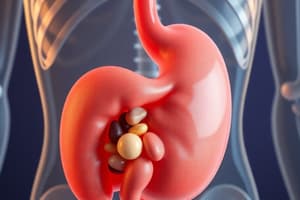Podcast
Questions and Answers
What is the most common cause of cholecystitis?
What is the most common cause of cholecystitis?
A blockage in the cystic duct from a gallstone.
What are the typical symptoms of cholecystitis?
What are the typical symptoms of cholecystitis?
Fever and right upper quadrant (RUQ) pain.
What is the next best step after diagnosing cholecystitis?
What is the next best step after diagnosing cholecystitis?
Perform an ultrasound.
Which condition is characterized by elevated liver function tests (LFTs) and RUQ pain?
Which condition is characterized by elevated liver function tests (LFTs) and RUQ pain?
What is the treatment of choice for cholangitis?
What is the treatment of choice for cholangitis?
What is the typical best initial test for suspected diverticulitis?
What is the typical best initial test for suspected diverticulitis?
What does a HIDA scan primarily diagnose?
What does a HIDA scan primarily diagnose?
What is the second-line treatment for symptomatic cholelithiasis?
What is the second-line treatment for symptomatic cholelithiasis?
What is the most accurate test for diagnosing diverticulosis?
What is the most accurate test for diagnosing diverticulosis?
What is the treatment of choice for diverticulitis?
What is the treatment of choice for diverticulitis?
What are the characteristic lesions seen in Crohn's Disease?
What are the characteristic lesions seen in Crohn's Disease?
What is the first-line treatment for Ulcerative Colitis flares?
What is the first-line treatment for Ulcerative Colitis flares?
Which condition is suggested by abdominal pain improved with defecation?
Which condition is suggested by abdominal pain improved with defecation?
What should be ruled out as the next best step in suspected cases of IBS?
What should be ruled out as the next best step in suspected cases of IBS?
What is a common treatment for constipation-predominant IBS?
What is a common treatment for constipation-predominant IBS?
What are two acceptable first-line alternatives for treating diverticulitis?
What are two acceptable first-line alternatives for treating diverticulitis?
Study Notes
Cholecystitis
- Most commonly caused by cystic duct blockage due to gallstones.
- Symptoms include fever and right upper quadrant (RUQ) pain lasting a few hours.
- RUQ tenderness on examination; positive Murphy's sign indicated by cessation of inspiration during palpation.
- Liver function tests (LFTs) typically normal.
- Ultrasound reveals thickening of the gallbladder.
- Next step in management: Ultrasound.
- Most accurate diagnostic test: HIDA scan.
- Initial treatment: NPO (nothing by mouth), IV hydration, and analgesic (Ketorolac).
- Second-line treatment: Laparoscopic cholecystectomy.
Cholelithiasis and Choledocholithiasis
- Most common stone type: mixed cholesterol stones.
- Black-pigmented stones linked to hemolytic disease.
- Brown-pigmented stones often associated with infection.
- Acute cholecystitis is a common complication.
- Cholelithiasis: typically asymptomatic, normal LFTs.
- Choledocholithiasis: symptomatic, elevated LFTs, and ultrasound shows biliary duct dilation.
- Best initial test for both conditions: Ultrasound.
- Most accurate test for choledocholithiasis: Endoscopic ultrasound (EUS).
- Treatment of choice for choledocholithiasis: ERCP (endoscopic retrograde cholangiopancreatography).
- Second-line treatment for asymptomatic cholelithiasis: observation; for symptomatic: cholecystectomy.
- Choledocholithiasis management: ERCP stone removal followed by cholecystectomy.
Cholangitis
- Most often caused by choledocholithiasis.
- Common pathogens include E. coli and Klebsiella.
- Classic presentation: RUQ pain, fever, jaundice; may include altered mental status and shock.
- LFTs elevated.
- Priority: stabilize the patient if unstable.
- Best initial test: Ultrasound; if negative, proceed to MRCP; if positive, do ERCP.
- Most accurate test: MRCP.
- Treatment of choice: IV antibiotics, IV fluids, analgesia, and biliary drainage via ERCP.
- Second-line treatment: Cholecystectomy after resolution of acute cholangitis for patients with choledocholithiasis.
Diverticulosis and Diverticulitis
- Diverticulitis noted in older patients (60s) with acute fever and left lower quadrant pain.
- Diverticulosis typically asymptomatic, may cause left lower quadrant pain with painless hematochezia, but no fever.
- Best initial test for diverticulosis: Colonoscopy; for diverticulitis: CT scan.
- Most accurate test for both: Colonoscopy for diverticulosis, CT scan for diverticulitis.
- Treatment of choice for diverticulosis: increase fiber and hydration.
- Diverticulitis treated with ciprofloxacin plus metronidazole, or alternatives like trimethoprim-sulfamethoxazole plus metronidazole, Augmentin, or moxifloxacin.
- Second-line treatment: Surgery if symptoms persist, recur, or complications arise.
Inflammatory Bowel Disease (IBD)
- Common symptoms include abdominal pain, hematochezia, fever, and weight loss.
- Crohn's Disease: skip lesions, transmural lesions, ASCA positive, may involve perianal region.
- Ulcerative Colitis: continuous lesions limited to colon, mucosal surface affected, pANCA positive, no perianal involvement.
- Most accurate test for IBD: Colonoscopy and biopsy.
- Treatment of choice for Crohn's: Steroids for flares, Budesonide for remission, Mesalamine or sulfasalazine for maintenance.
- Ulcerative Colitis treatment: Steroids for flares, topical mesalamine for remission, maintenance with topical mesalamine or sulfasalazine.
- Second-line treatment for refractory or moderate/severe disease includes anti-TNF medications (Infliximab, Adalimumab) and possibly Azathioprine.
- Surgery may be curative for Ulcerative Colitis but not for Crohn's.
Irritable Bowel Syndrome (IBS)
- Most common cause of recurrent abdominal pain in the U.S., more prevalent in women.
- Symptoms: abdominal pain improved with defecation, alternating constipation and diarrhea, normal labs and imaging.
- Next best step: Rule out other causes of abdominal pain.
- Treatment of choice includes adequate hydration, dietary fiber, and antispasmodic medications (hyoscyamine or dicyclomine).
- For constipation-predominant IBS, osmotic laxatives (Linaclotide, lubiprostone, plecanatide) can be effective.
Studying That Suits You
Use AI to generate personalized quizzes and flashcards to suit your learning preferences.
Description
This quiz covers key concepts related to cholecystitis, cholelithiasis, and choledocholithiasis, including causes, symptoms, diagnosis, and treatment options. Understand the nuances of gallstone diseases and their clinical management. Test your knowledge on important diagnostic tests and complications.




